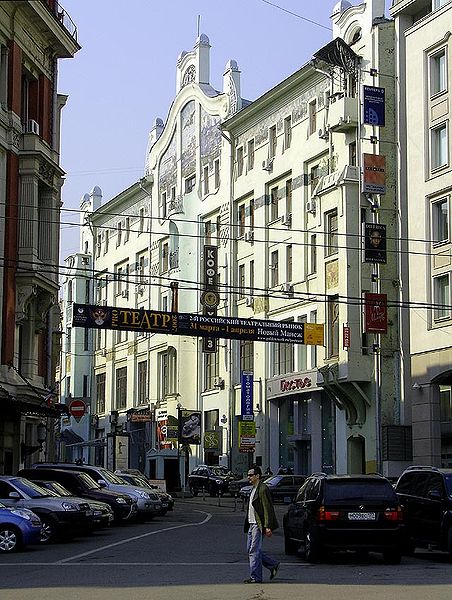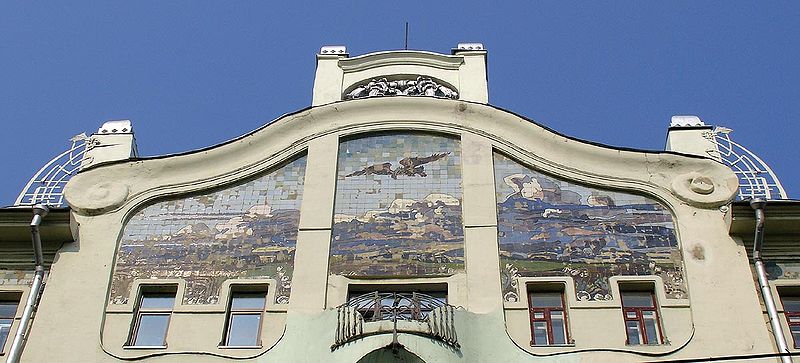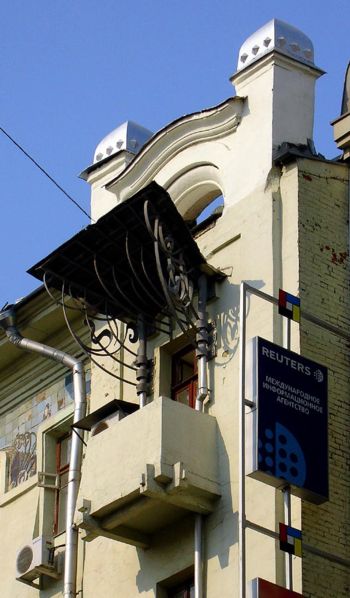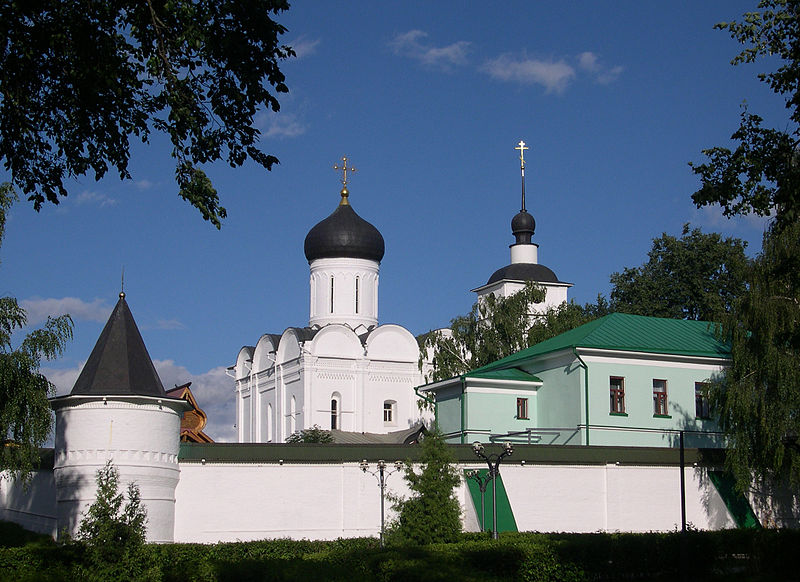<Back to Index>
- Architect Roman Ivanovich Klein, 1858
- Architect Ivan Pavlovich Mashkov, 1867
PAGE SPONSOR
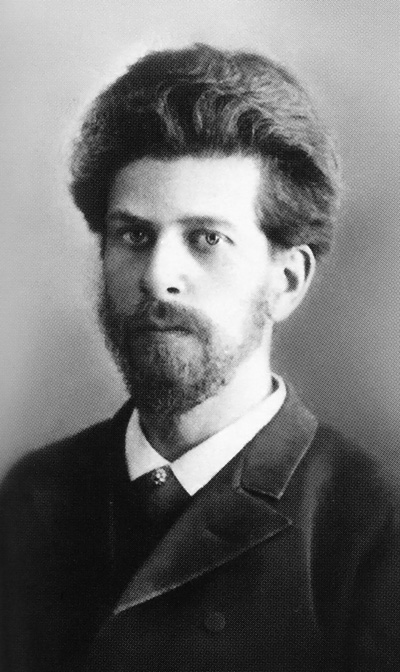
Roman Ivanovich Klein (Russian: Роман Иванович Клейн), born Robert Julius Klein, was a Russian architect and educator, best known for his Neoclassical Pushkin Museum in Moscow. Klein, an eclectic, was one of the most prolific architects of his period, second only to Fyodor Schechtel. In 1880s - 1890s, he practiced Russian Revival and Neo-Gothic exteriors; in 1900s, his knowledge of Roman and Byzantine classical architecture allowed him to integrate into the Neoclassical revival trend of that period.
Klein was born in a wealthy merchant family. He
trained at the Moscow School of
Painting, Sculpture and Architecture (1873
1874), with Vladimir Sherwood on the
construction site of State Historical Museum (1875
1877), and at the Imperial Academy of
Arts (1877
1882), winning a study tour to Italy and France (1883
1884), where he assisted Charles Garnier in
preparation to the Exposition Universelle
(1889). Klein returned to
Moscow in 1885, worked as junior architect at local
firms and went independent in 1888.
Most of Klein's professional career revolved around
the 16-year Pushkin Museum project. The public contest of
1896, managed by Moscow State University, awarded the first prize to Pyotr
Boytsov; Klein
used Boytsov's general layout but the exterior and
interior styling is Klein's own, undisputed work. His
knowledge of Greek and Byzantine classics was evident,
however, the University also wanted perfection in other
historical interiors (Egyptian, Babylonian) and sent
Klein on two overseas study tours (1897, 1899 1900).
Klein had studied the latest forms of museum
construction in Europe, and he built a temple to the
arts that expressed civic pride and private patronage,
thus pleasing his benefactor, Nechaev - Maltsov, and creating what Lukomskii
would have called approvingly a "European" building,
noticeably different from the public and commercial
buildings whose neoclassicism derived from the local Empire style. Klein employed Vladimir Shukhov for structural engineering of ceilings
and sunroofs, Ivan Rerberg and
other younger architects. The museum was generally
complete by 1907; finishing works and expansions lasted
to 1912.
Klein was in high demand among Moscow businessmen expanding their retail and warehouse facilities. He completed such high profile buildings like Neo-Gothic TsUM department store (1906 1908, originally, Moor and Merilise store) in Petrovka Street and pseudo - Russian Middle Trade Rows in Kitai-gorod (1901 1902). Klein also completed a number of banks and office blocks in Kitai-gorod and other districts of Moscow.
Less known is his prodigious input to industrial architecture; Klein was the house architect for Moscow industrialists like Giroud, Huebner (textile and rubber mills in Khamovniki District) and Gougon (steel mills in Lefortovo District). His lesser customers ranged from country farms and breweries to Moscow's first aircraft plant (Khrunichev). Most of these buildings, with few exceptions, were later rebuilt or demolished.
Klein contributed to the Devichye Pole campus project, building the Cancer Clinic, Gynaecology Clinic and student dormitories in 1896 - 1903; his own house and rental apartment building were located in nearby Olsufyevsky Lane. He designed numerous Orthodox, Lutheran and Catholic churches in Moscow and other cities and supervised construction of Moscow Choral Synagogue (designed by Semyon Eybushits). As a private architect to the Shelaputin family, he completed various Shelaputin Schools (for general and professional education).
Modern critics place Klein's
talent below his contemporaries like Fyodor Schechtel or Lev Kekushev (Maria
Naschokina). All his work belong to eclecticism, which
was normal for 1880s but completely outdated by 1900s.
This may be interpreted as either loyalty to his
personal style, or as inability to follow the novel
trends of his period. Klein had his limitations, but his
immense academic background and drawing skills allowed
him to imitate styles like Victorian architecture or Russian
Revival. His
buildings like the Nekrasov House are sometimes listed
as Art Nouveau, but Klein actually did not
venture into this style. After 1905, when public
discarded Art Nouveau, his neoclassical skills put him in the
middle of Neoclassical Revival of 1905 - 1914.
Klein, a successful businessman, possessed excellent skills in educating and managing people. His architectural firm trained dozens of architects who excelled in Art Nouveau (Yevlanov brothers), industrial architecture (Karl Gippius), Neoclassical revival (Ivan Rerberg) and later constructivist architecture (Grigory Barkhin). Klein treated these internships as his own educational work, not just hiring labor. He advocated "finding out the unique, individual features of a trainee architect, and bringing up his own creative conscience" ("выявление индивидуальности проектирующего ... и в воспитании в нем художественного самосознания"), and promoted the French model of architectural workshops.
In 1900s, Klein was active in the preservationism movement, performing surveys of historical buildings (notably, Domenico Giliardi's University building); publication of his books about these studies was interrupted by World War I.
Unlike other architects of his generation, Klein easily integrated into the Soviet reality of the Civil War period - he retained his formal employment as an architect of the Historical and Pushkin Museums and the chair at Moscow State Technical University and even received practical (but unimportant) commissions in 1922 - 1923. He took part in the architectural competitions of early 1920s, side by side with the new generation of avant garde architects.
Roman Klein died in 1924 and is
interred at the former German now - Vvedenskoye Cemetery in Lefortovo District.
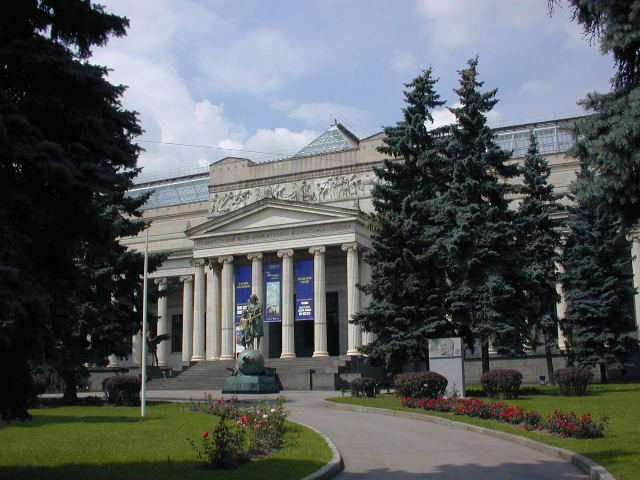
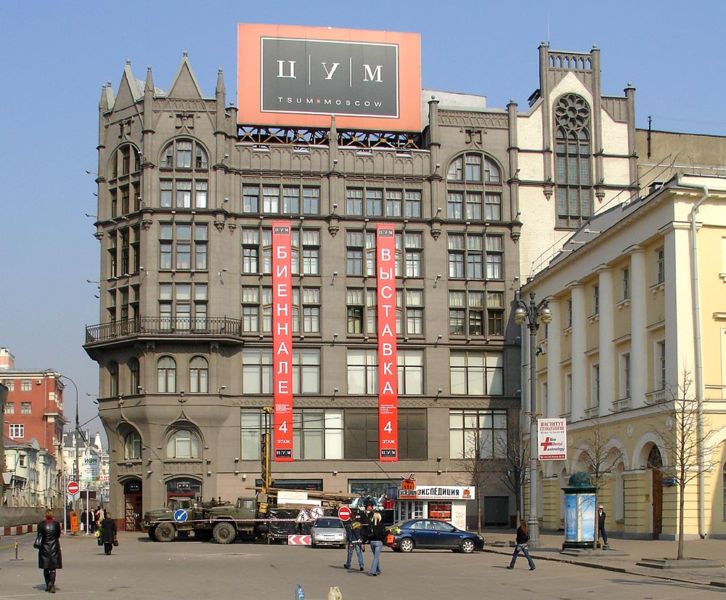
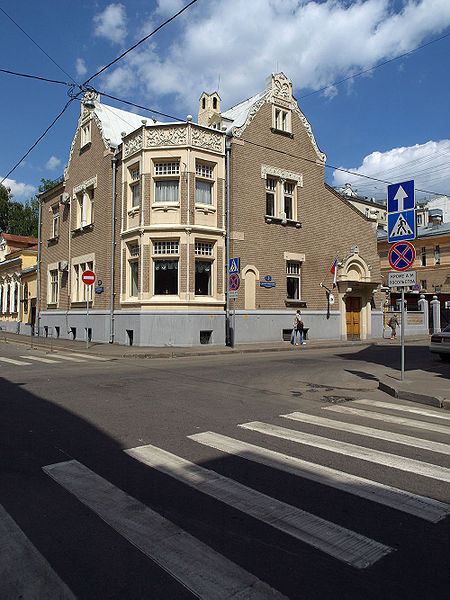
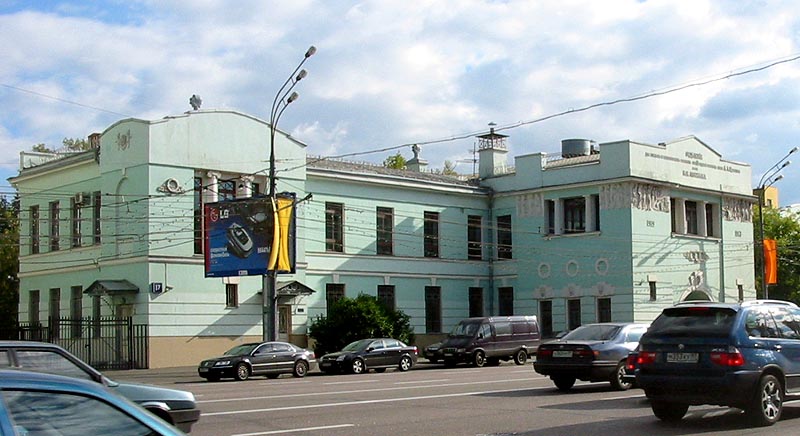
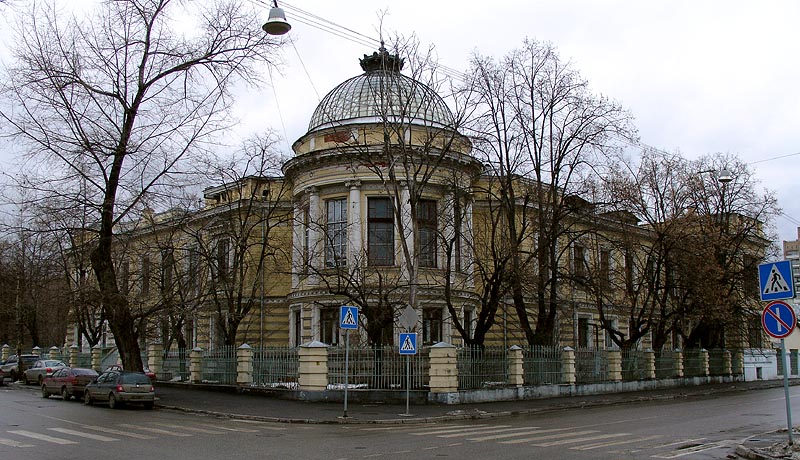
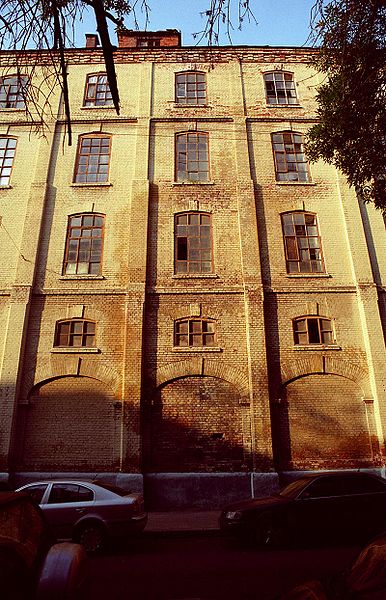
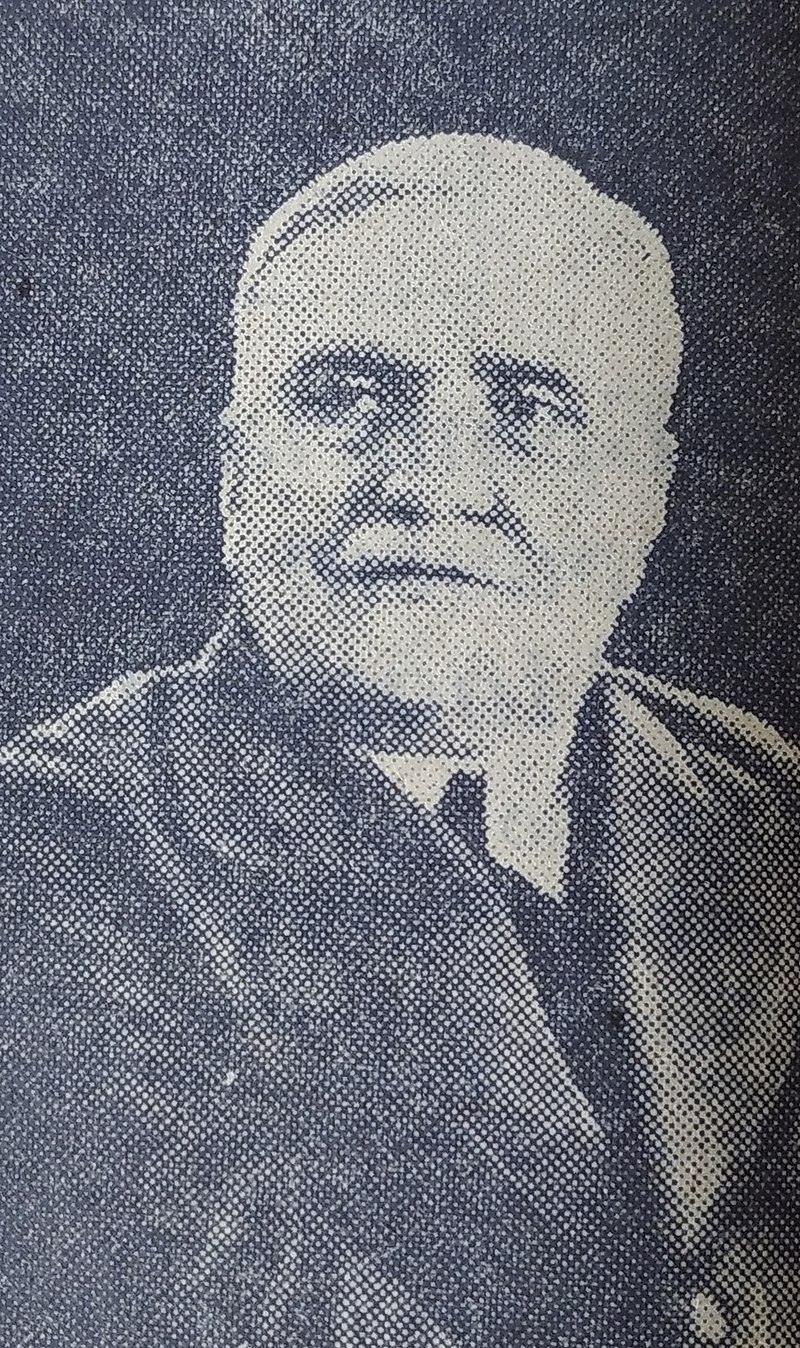
Ivan Pavlovich Mashkov (Russian: Иван Павлович Машков, 1867 1945) was a Russian architect and preservationist, notable for surveying and restoration of Dormition Cathedral of Moscow Kremlin, Novodevichy Convent and other
medieval buildings. His best known extant building is Sokol (Falcon)
luxury Art Nouveau apartment
building in Kuznetsky Most Street, Moscow. A prolific architect, Mashkov
built mostly eclectic buildings with Russian
Revival features.
Ivan Mikhailovich Sokolov (Иван Михайлович Евдокимов), son of a village blacksmith, lost both his parents in early childhood. He was adopted by Pavel Karpovich Mashkov, a Lipetsk businessman, and his wife, Natalya Yefimovna (née Andreyeva), thus acquiring the name of Mashkov. Natalya's brother, Alexey Yefimovich Andreev, was a town architect in Lipetsk.
In 1881, Ivan was admitted to Moscow School of Painting, Sculpture and Architecture. He graduated from Alexander Kaminsky's class of architecture with an honorary medal and a construction license in 1886 at the age of 19 an exceptionally quick education by any standard (normally, it would take 10 to 15 years from admissions to professional license).
In 1885
1888, Mashkov assisted Konstantin Bykovsky on Devichye Pole campus
planning and August Weber on the
completion of the Polytechnical Museum in Moscow. In
1889 1890 he visited Lipetsk and completed there two
schools, a hospital and a prison chapel at the age of
23. Back in Moscow, Mashkov completed over a dozen
buildings still in his twenties, and his masterpiece the
Sokol
at the age of 36.
Mashkov's Sokol (Falcon) building is unique not only for his career, but for Moscow Art Nouveau in general. It is the only building in the city designed in original Vienna Secession style. Its gilded roof and abundant forged iron ornaments looked like a citation from Otto Wagner (these ornaments were eventually lost). At the same time, the building is definitely Muscovite; the shape of its frieze repeats the lines of nearby Hotel Metropol.
The majolica mosaic of a falcon
flying over a stormy sea was made by Nikolay Sapunov (of Mir Iskusstva art group).
The subject of this picture itself is a double citation
from Maxim Gorky's Song of a
falcon (1899)
and from nearby Moscow Art Theater's Seagull
symbol (1903). However, the building has nothing to do
with these symbols or with Mashkov's natural name it was
named after M.V.
Sokol, the owner.
Mashkov's work prior to Sokol belongs to traditional muscovite eclectics and moderate Russian Revival of 1880s - 1890s, and does not stand out among hundreds of similar buildings of this period. An unusually large share of his work was built for public charities, which ruled out expensive decorations and interiors. The only decoration he allowed was Abramtsevo majolica.
After the Russian Revolution of 1905,
the public lost the interest in Art Nouveau; architects responded with
a revival of Neoclassicism. Mashkov completed two private
buildings (Tverskoy Pawn Shop and Eggert Apartments) in a
stern, Saint Petersburg version of this style.
In 1912 - 1913, he built his last major project -
psychiatric hospital in Poteshnaya Street (now, Gannushkin
Hospital). These buildings did not make architectural
landmarks; Mashkov, however, did make a lasting statement
with his iconic monument to Ivan Fydorov (sculpture by Sergei Volnukhin).
Like many contemporary architects, Mashkov was keen on studying and preserving historical national architecture, and in 1898 joined the Moscow Archaeological Society. He surveyed many historical churches and monasteries in Moscow, Dmitrov, Borovsketc, published his own studies and edited the journal of the Society. Mashkov supervised restoration of Kremlin cathedrals, Sukharev Tower, St.Basil Cathedral and other memorial buildings. In 1908 - 1918, he also co-chaired the Moscow Architectural Society and contributed to the construction of the House of Architects (17, Yermolayevsky Lane, currently Museum of Modern Art). In 1908 - 1933, he managed the Architectural Department of the Polytechnical Museum, the forerunner of present day Museum of Architecture. He is credited with editing the best guide to the architecture of Moscow (1913).
Despite his
reputation as preservationist and archaeologist, Mashkov
joined the emerging skyscraper movement in 1913, and
proposed a 13-story highrise on Tverskaya Street. The City Hall blocked
this proposal and banned further highrise construction in
the center of Moscow.
At the time of Russian Revolution of 1917, Mashkov was employed by the City of Moscow as deputy to City Architect. Bolshevik administration retained him in his office, and for some time Mashkov acted as the City Architect, engaged mostly in maintenance of the city in the middle of a civil war.
In 1929, Mashkov and sculptor Nikolay Andreyev erected the neoclassical monument to Aleksandr Ostrovsky near Maly Theater. Mashkov continued surveying memorial buildings (some of them already scheduled for demolition) and headed the restoration of Pashkov House (then known as Rumyantsev Museum, later Lenin Library and Russian State Library). He took no part in architectural disputes of 1920s, but was present in professional journals and wrote college textbooks (1935).
In 1934, Mashkov became a professor in Moscow Architectural Institute; since 1935 he chaired the department of architecture of Moscow Construction Institute. In 1937, he was awarded the title of Hero of Labor (1927 statute, predecessor of 1938 Hero of Socialist Labor title). Mashkov remained well established in Soviet academic circles until his death and was buried with honors at Novodevichy Cemetery; his book on Novodevichy Convent was reissued posthumously in 1949.
